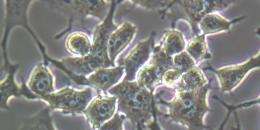Designer compounds inhibit prion infection

(Medical Xpress) -- A team of University of Alberta researchers has identified a new class of compounds that inhibit the spread of malfunctioning proteins in the brain that cause lethal neurodegenerative diseases in humans and animals.
Neurodegenerative disorders like Creutzfeldt-Jakob disease in humans, and associated brain diseases in cattle, sheep, deer and elk populations, can all be traced to malfunctioning proteins.
U of A chemistry researcher Frederick West says this protein, located in the brain, folds into a specific shape that is required for it to function properly.
But when the folding mysteriously goes awry the result is a prion, derived from the words protein and infection. Researchers don’t know how or why proteins become badly folded, but prions are believed to be toxic to the brain.
West and his team have developed compounds that clear prions from infected cells derived from the brain.
“When these designer molecules were put into infected cells in our lab experiments, the numbers of misfolded proteins diminished—and in some cases we couldn’t detect any remaining misfolded prions,” said West.
West and his collaborators at the U of A’s Centre for Prions and Protein Folding Diseases say this research is not yet a cure, but does open a doorway for developing treatments.
“We’re not ready to inject these compounds in prion-infected cattle,” said David Westaway, director of the prion centre. “These initial compounds weren’t created for that end-run scenario.”
West notes that the most promising experimental compounds at this stage are simply too big to be used therapeutically in humans or animals.
“There’s a molecular size limit for getting a drug into the bloodstream through the stomach,” said West. “Then there’s the complex chemistry required for developing drug molecules that can cross the blood- brain barrier into the central nervous system.”
Human exposure to prion-triggered brain disorder is limited to rare cases of Creutzfeldt-Jakob or mad cow disease. The researchers say the human form of mad cow disease shows up in one in a million people in industrialized nations, but investigating the disease is nonetheless well worth the time and expense.
“There is a strong likelihood that prion diseases operate in a similar way to neurodegenerative diseases such as Alzheimer’s, which are distressingly common around the world,” said West.
The research was funded by a $200,000 grant from the Alberta Prion Research Institute, part of Alberta Innovates Bio Solutions.
The lead author on the research was Charles Mays of the Centre for Prions and Protein Folding Diseases. Other U of A researchers came from the departments of chemistry, neurology and biochemistry. The research was published in the journal Biomaterials.















